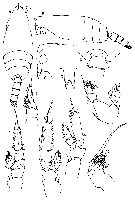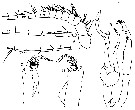|
|
 |
|
Calanoida ( Order ) |
|
|
|
Clausocalanoidea ( Superfamily ) |
|
|
|
Scolecitrichidae ( Family ) |
|
|
|
Scottocalanus ( Genus ) |
|
|
| |
Scottocalanus sp. Morris, 1970 (M) | |
| | | | | | | Ref.: | | | Morris, 1970 (p.2301, 2309, Descr.M, figs.M, Rem.) |  issued from : B. Morris in J. Fish. Res. Bd Canada, 1970, 27 (12). [p.2310, Fig.6]. Male (from 28°22'N, 160°01'W): A-B, habitus (dorsal and lateral, respectively); C, forehead (lateral); D, posterior prosome and urosomal segment 1 (dorsal); E, rostrum (anterior); F, Md (mandibular palp); G, Mx2; H, P1; I, P2 (anterior); J, P3 (anterior); K, abnormal P4 (anterior). Nota: Proportional length of prosome to urosome 25 : 10. General body shape as in S. helenae. Body a rich brown color. Cephalic crest triangular. Rostral plate width (at base) to length (base to tip of points) in ratio of 10 : 14 ; rostralpoints occupying 0.6 depth of depression. posterior corners of prosome rounded in lateral view but with distinct posterioventral notch. Corners produced into irregularly rounded lobes in dorsal view. Urosome 5-segmented, and including caudal rami, of proportional lengths 65 : 80 : 75 : 75 : 10 : 25. Urosomal segment 1 asymmetrical and produced on both right and left lateral margins, that the left more pronounced and with conspicuous genital slit. Urosomal segments 2-4 with distinct scalelihe teeth along distal margins. A2, Mx2 and Mxp as in S. helenae. Md with exopodite 5-segmented, bearing 1 seta each on segments1-4, and 2 setae on segment 5. Endopodite 2-segmented with 2 slender setae on segment 1 and with 9 terminal setae and horizontal row of about 7 spinules on segment 2.
|
 issued from : B. Morris in J. Fish. Res. Bd Canada, 1970, 27 (12). [p.2309]. Male: Proportional lengths of segments of A1. Nota: Fusion of segments 8, 9 and 10-13. Partial fusion of segments 10-13 with 14, and 15 with 16.
|
 issued from : B. Morris in J. Fish. Res. Bd Canada, 1970, 27 (12). [p.2311, Fig.7]. Male: A, A1; B, P5; C, left exopod ite 3 of P5; D, same (another view). Nota : A1 as in S. helenae male. Fusion of segments 8, 9, and 10-13. Partial fusion of segments 10-13 with 14, and 15 with 16. P5Anterior surface spinules on exopod and endopod of P2 and P3. Only unbroken exopod of P4 unusual in being bimerous, devoid of external marginal spines and possessing a nonserrate terminal spine. This is probably a regeneratd leg. Endopod of P4 normal and with a few anterior surface spinules. P5 : Right P5 with sxollen basipodite 2, long curved bimerous endopod, and trimerous exopod with segments of proportional lengths 31 : 16 : 10. Right P5 endopod reaching distal margin of right exopodite segment 1. Left P5 with basipodite segments 1 and 2 of equal lengths. Left endopod unimerous, rudimentary. Left exopod trimerous, segments of proportional lengths 40 : 54 : 10. Left endopod 0.7 length of left exopodal segment 1. Left exopodal segment 2 with distinct subtriangular carina on midsurface, and with rounded process at inner distal. Left exopodal segment 3 with foliate, apically serrate process, 2 apical bristles, and numerous (about 10) smaller hairs along inner proximal margin. In natural position, P5 overreaching caudal rami by almost one-third their length.
| | | | | NZ: | 1 | | |
|
Distribution map of Scottocalanus sp. by geographical zones
|
| | | | Loc: | | | N Pacif. (off N Hawaii) | | | | N: | 1 | | | | Lg.: | | | (92) M: 3,68; {M: 3,68} | | | | Rem.: | mesopelagic.
For Morris (1970, p.2311) the male differs from S. persecans, S. helenae, S. farrani and S. thori. The males of S. backusi Grice, 1968, S. sedatus Farran, 1936, and S. setosus A. Scott, 1909, are unknown. Of these, S. sedatus occurs in the Pacific Ocean and is of similar size (3.1-3.4 mm) to the male collected. | | | Last update : 31/01/2015 | |
|
|
 Any use of this site for a publication will be mentioned with the following reference : Any use of this site for a publication will be mentioned with the following reference :
Razouls C., Desreumaux N., Kouwenberg J. and de Bovée F., 2005-2025. - Biodiversity of Marine Planktonic Copepods (morphology, geographical distribution and biological data). Sorbonne University, CNRS. Available at http://copepodes.obs-banyuls.fr/en [Accessed December 03, 2025] © copyright 2005-2025 Sorbonne University, CNRS
|
|
 |
 |





